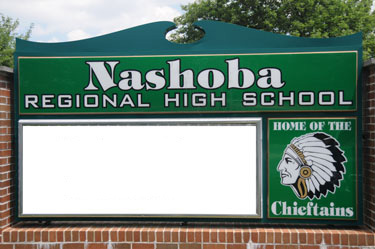By Ann Needle

On Monday, voters in Lancaster rejected borrowing the money needed for a proposed Science lab renovation at Nashoba Regional High School. This leaves Stow residents with one less item to debate at its special Town Meeting on October 29.
At Lancaster’s special Town Meeting, residents voted 167 vs. 66 against the Nashoba district’s borrowing of the funds needed for the lab renovation. Because all three district towns needed to approve the funding in order for it to go through, the Lancaster vote determined the project outcome for the other two towns with later Town Meetings. (Bolton’s special TM was last night.)
Stow Town Administrator Bill Wrigley commented that he expects a move for “no action” at the town’s October 29 TM on the lab borrowing, which had already been included in the warrant. This would cancel out any vote on the labs called for on the November 6 ballot. Nashoba Superintendent Michael Wood noted that, given Lancaster’s vote, he is not planning on presenting anything at the October 18 open forum in Stow on proposed capital planning projects.
The Lancaster vote capped a process that officially began in June, when Superintendent Michael Wood announced to the public that the Massachusetts School Building Authority approved NRHS, along with several other state high schools, for a Science lab renovation grant. Earlier in the year, he informed the Nashoba School Committee that the district had applied for the grant.
Similar to the Center School project funding, the state agency pledged to pay almost half the entire cost for the lab overhaul, from feasibility study and design through construction. The MSBA would have required the renovation to be completed by next fall.
Wood argued that the Science space at the high school has been cramped and outdated, leaving the school with scheduling issues that could come up during re-accreditation in a few years. The project would have redesigned the space using guidelines from the National Science Foundation and the National Science Teachers Association, he said.
Lancaster voters had pointed criticism for the plan at Monday night’s meeting.
“We feel the proposal was presented to the town in a hasty, rushed manner,” maintained Lancaster Finance Committee Vice Chair Peter CampoBasso, as he summarized why FinComm was not supporting approval of the debt. Nashoba did not formally show Lancaster officials the plans until August, leaving the town with no time to weigh the issue, he said. The district has just paid off its debt from the financial crisis of a decade ago. And, CampoBasso added, “We feel the price is a bit too high.”
After a presentation by Michael Wood and School Committee Chair Nancy Federspiel of Bolton, there were only a few residents queued for questions. One voter pointed at the timing of the project’s announcement, which came after the towns approved borrowing in May to overhaul the high school’s main field and track. Wood reiterated that the MSBA did not approve Nashoba for the Science grant until June, “And we didn’t think we would be invited to participate.”
Also asked why the district would not be tapping into its free cash to help defray any cost, Wood replied that Nashoba returns about half that account to the towns annually, and, “A million of that is included in our revenue stream right now.”
What’s Next
With the grant off the table, the district still has issues it may need to address with the labs fairly soon. The most pressing likely will be replacing the roof of the wing added in the 1970s, something that would have been included in the grant. Wood said this will need to be done in the next five years, at a cost of about $900,000. (Nashoba estimated the current roof replacement cost at $750,000, with the state paying about 47% if borrowing for the project had passed.)
Wood reminded residents of another reason for Nashoba to focus on rehabbing Science space. During the last re-accreditation process by the New England Assn. of School and Colleges, Wood said the regional accreditation body asserted, “Science classes are running the schedule.” Wood attributed much of this issue to lack of scheduling space, leaving students to plan the rest of their schedules around too few Science options.
Wood acknowledged that the condition of the labs themselves — while worn and definitely calling for repairs — probably would not threaten re-accreditation from NEASC. Should the district not expand Science space before the next re-accreditation process in about two years, NEASC would likely cite NRHS for scheduling issues again, he said.
As Nashoba prioritizes what needs to be done with the labs, the MSBA grant did get some use. When voting this summer to pursue the project, the School Committee reasoned that the state would pay about 47% of the up to $320,000 it approved for the feasibility study and design, whether construction ever happened. At a reasonable cost, the Committee said this would leave the district with a formal plan to overhaul the labs at some point in the future.